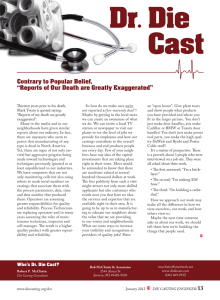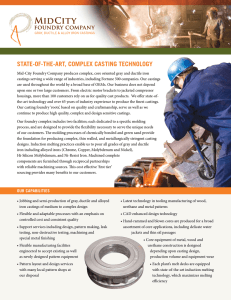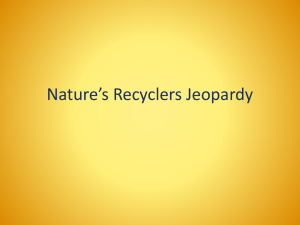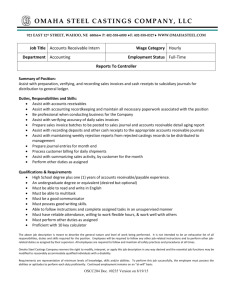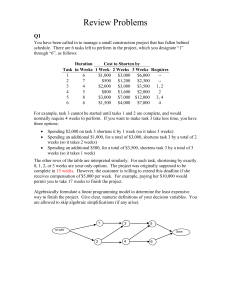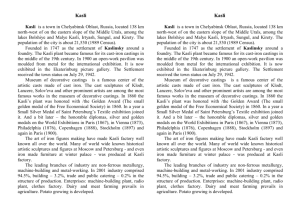IS 3444 (1999): Corrosion Resistant High Alloy Steel And Nickel
advertisement
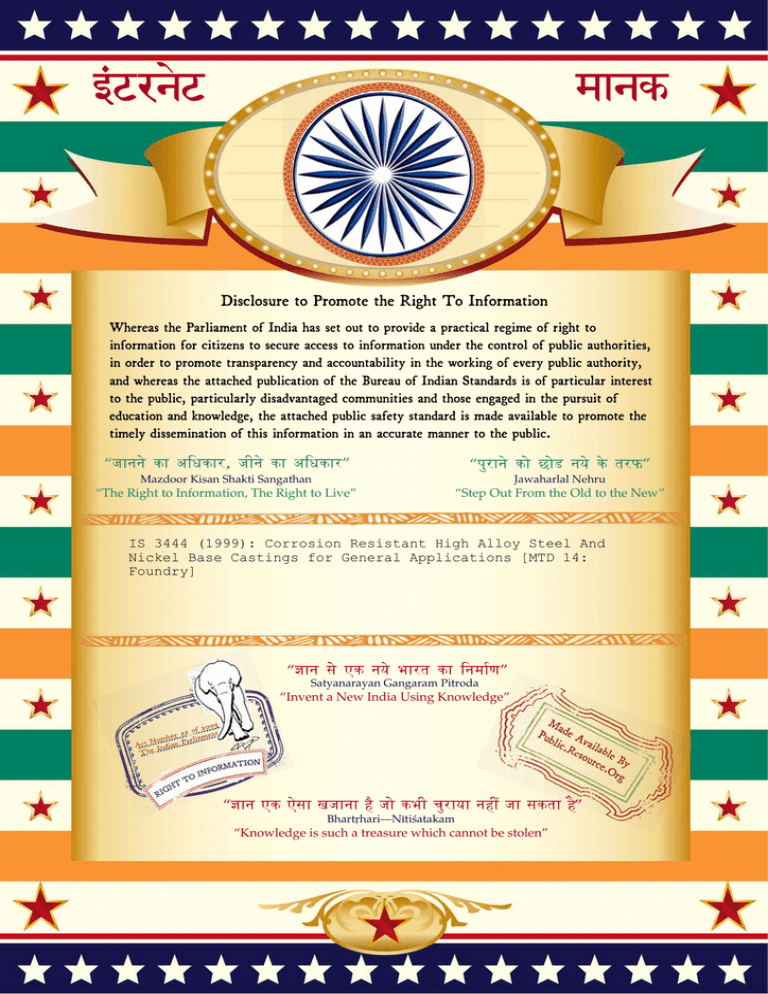
इंटरनेट मानक Disclosure to Promote the Right To Information Whereas the Parliament of India has set out to provide a practical regime of right to information for citizens to secure access to information under the control of public authorities, in order to promote transparency and accountability in the working of every public authority, and whereas the attached publication of the Bureau of Indian Standards is of particular interest to the public, particularly disadvantaged communities and those engaged in the pursuit of education and knowledge, the attached public safety standard is made available to promote the timely dissemination of this information in an accurate manner to the public. “जान1 का अ+धकार, जी1 का अ+धकार” “प0रा1 को छोड न' 5 तरफ” “The Right to Information, The Right to Live” “Step Out From the Old to the New” Mazdoor Kisan Shakti Sangathan Jawaharlal Nehru IS 3444 (1999): Corrosion Resistant High Alloy Steel And Nickel Base Castings for General Applications [MTD 14: Foundry] “!ान $ एक न' भारत का +नम-ण” Satyanarayan Gangaram Pitroda “Invent a New India Using Knowledge” “!ान एक ऐसा खजाना > जो कभी च0राया नहB जा सकता ह” है” ह Bhartṛhari—Nītiśatakam “Knowledge is such a treasure which cannot be stolen” Indian Standard CORROSION RESISTANT HIGH ALLOY STEEL AND NICKEL BASE CASTINGS FOR GENERAL APPLICATIONS - SPECIFICATION ( Third Revision) ICS 77.140.20 0 BIS 1999 BUREAU OF INDIAN STANDARDS MANAK BHAVAN, 9 BAHADUR SHAH ZAFAR MARG NEW DELHI 110002 September 1999 Price Group 4 Steel Castings Sectional Committee, MTD 17 FOREWORD This Indian Standard (Third Revision) was adopted by the Bureau of Indian Standards, after the draft finalized by the Steel Castings Sectional Committee had been tipproved by the Metallurgical Engineering Division Council. This standard was first published in 1966 and was subsequently revised in 1978 and 1987. In the present revision the following main modifications have been made: a) Various clauses have been aligned with the recent standards on Steel Castings; b) The list of referred standards is annexed; c> The 4 definition on cast melt has been modified; Clause’s on supply of material and non-destructive tests have been modified; and e) Clause, on particulars to be specified while ordering has been included in the main text of the standard. Corrosion resistant steel castings are used in various industries such as chemicals dyes petroleum refining, pharmaceuticals, food processing, paper, sugar, etc, for services at normal atmospheric or elevated temperatures. The alloy combinations of these castings are chiefly iron-chromium, iron-chromium-nickel, nickel-molybdenum, nickel and nickel-copper type. For applications involving corrosion at elevated temperature, reference should be made to IS 7806:1993 ‘Martensitic and austenitic high alloy steel castings for high temperature service (second revisions . Typical applications are given in Annex C. In formulating this standard, assistance has been derived from ASTM A : 743/A743M-93a ‘Specification for corrosion resistant iron-chromium, iron-chromium-nickel and nickel base alloy castings for general application’, issued by the American Society for Testing and Materials. For the purpose of deciding whether a particular requirement of this standard is complied with the final value observed or calculated, expressing the result of a test or analysis, shall be rounded off in accordance with IS 2 : 1960 ‘Rules for rounding off numerical values (revised)‘. The number of significant places retained in the rounded off value should be the same as that of the specified value in this standard. IS 3444 : 1999 Indian Standard CORROSION RESISTANT HIGH ALLOY STEEL AND NICKEL BASE CASTINGS FOR GENERAL APPLICATIONS - SPECIFICATION ( Third Revision) 7 PARTICULARS ORDERING 1 SCOPE This standard covers the requirements for high alloy steel and nickel base castings suitable for corrosion resistant applications. TO BE- SPECIFIED WHILE For the benefit of purchaser, particulars to be specified while ordering for the castings under this specification are given in Annex B 2 REFERENCES 8 CHEMICAL COMPOSITION Indian Standards listed in Annex A are necessary adjuncts to this standard. 8.1 The ladle analysis of material, when carried out either by the method specified in IS 228 and its relevant parts or any other established instrumental/ chemical methods, shall be as given in Table 1. In case of dispute, the procedure given in IS 228 shall be the referee method. However, where the method is not given in IS 228 the referee method shall be agreed to between the purchaser and the manufacturer. 3 TERMINOLOGY 3.1 For the purpose of this standard, the following definitions shall apply. 3.1.1 Cusr (Melt) following: The product of any one of the a) One furnace heat, b) One crucible heat, or c) A number of furnaces or crucible heats of similar composition mixed in a ladle before pouring. 8.2 The manufacturer shall carry out analysis from a sample of each melt and, if so specified by the purchaser at the time of enquiry and order, shall supply a test certificate of chemical analysis of sample of material for each melt. 8.3 Product Analysis If specified at the time of enquiry and order, the product analysis may be carried out from a broken tensile test piece or from a casting representing each melt. Drillings for analysis shall be taken from not less than 6 mm beneath the cast surface, and in such a manner as not to impair the usefulness of any casting selected. The permissible variation in product analysis from the limits specified in Table 1 shall be as given in IS 6601. 3.1.2 Batch - A group of castings of one grade of material, cast from the same melt and heat treated together under identical conditions. 4 GRADES This standard covers a total of 27 grades of corrosion resistant high castings (see. Table 1). 8.4 Residual Elements 5 SUPPLY OF MATERIAL 8.4.1 Elements not specified in Table 1, need not ordinarily be added to the steel and all reasonable precautions shall be taken to prevent contamination from scrap, etc, to keep them as low as practicable. General requirements relating to supply of-corrosion resistant high alloy steel and nickel base castings shall conform to IS 8800. 8.4.2 Analysis and reporting of the analysis in test certificate for the residual elements shall be done only when so specified by the purchaser in enquiry and order. However, the manufacturer shall ensure that the residual elements-are within the limits, when such limits are specified by the purchaser in enquiry and order. 6 MANUFACTURE The material for the castings shall be’made by electric arc or electric induction or such other processes as may be agreed to between the purchaser and the manufacturer. I IS 3444 : 1999 Table 1 Chemical Grade Requirements 4, 8.1, 8.3 and 8.4.1) (Chuses Constituent, Percentr) :) Mn 1 0.08 2.00 (4) 1.50 2 0.12 2.00 1.50 3 4 0.20 0.08 2.00 2.00 1.50 1.50 5 D.08 2.00 63, 0.16 6A3) 0.16 2.00 2.00 1.50 1.50 0.20 MO & A 0.04 0.04 0.04 0.04 0.04 0.04 0.04 0.04 0.04 0.04 0.04 * ; (8) 18.0-21.0 - 20.0-23.0 - 18.0-21.0 18.0-21.0 - 18.0-21.0 2.0-3.0 - (it) (E)(E)(G) 8.0-11.0 10.0-13.0 - - - - 8.0-11.0 9.0-12.0 - - - - 9.0-12.0 - - - 2, 1.50 0.17 18.0-21.0 1.5 Mm 0.04 0.20-0.40 18.0-21.0 0.40-0.80 2.00 1.50 0.04 0.04 22.0-26.0 - 12.0-15.0 - al0 2.00 1.50 0.04 0.04 22.0-26.0 - 12.0-15.0 - 8 0.20 2.00 2.00 0.04 OXI4 23.0-27.0 - 19.0-22.0 - - 8.0-11.0 - 7 7A’) 9.0-12.0 9.0-12.0 - 9 0.30 2.00 1.50 0.04 0.04 26.0-30.0 10 0.15 1.50 1.00 0.04 0.04 11 0.15 0.65 1.OO 0.04 0.04 11.5-14.0 0.50 Mm 11.5-14.0 0.15-1.0 12 0.30 1.50 1.00 0.04 0.04 18.0-21.0 - 2.0&x 13 0.50 1.50 1.00 0.04 0.04 26.0-30.0 - 14 0.20-040 1.50 1.00 0.04 0.04 15 16 0.03 0.03 2.00 1.50 1.50 1.50 0.04 0.04 0.04 0.04 17 18 19 0.08 0.07 0.12 1.50 1.50 1.50 1.50 0.04 1.50 0.04 1.00 0.040 0.04 0.04 0.040 9.0-13.0 18.0-21.0 3.040 19.0-22.0 2.0-3.0 27.5-30.5 15.50-20.00 16.0-20.0 Remainder - 20 0.40 3.00 1.50 0.030 0.030 14.00-17.00 21 1.00 2.00 1.50 0.030 0.030 22 0.35 2.00 1.50 0.030 0.030 22A 23 0.35 0.12 1.25 1.00 1.50 0.030 1.00 0.040 0.030 0.030 24 0.06 1.oo 1.00 0.040 0.03 11.5-14.0 0.50 Max 2.0-3.0 17.0-21.0 17.0-21.0 0.20-0.35 - - - - 1.0 MUX - - - - 4.0 Max - - - l.OMox - 5) - 1.0 Max 8.0-12.0 9.0-13.0 - - - - - Remainder - - - - Remainder - - 1.25 Max - - - - Remainder - - 26.0-33.0 - Remainder 1.00 Max 26~0-33.0 Remainder - - 26.0-33.0 - - 11.5-14.0 0.40-1.0 3.5-4.5 3.0-4.0 5.25 - - - 0.40 - 0.60 - (I) - Remainder - Remainder - Remain&r - Remain&r - Remain&r - Remainder - Remainder - Remainder - Remainder Remainder - Remainder - Remainder - Remainder - Remainder - Remainder - Remain&r - Remainder - Remainder - Remainder Remainder 2.50 7.50 11.00 3.00 2.50 - 3.50 3.50 6.00 - The value of constituents percentage should be treated as maximum wherever a range is not specified. Grade 5 shall have a niobium content of not less than 8 times the carbon content and not more than 1.0 percent. If a niobium plus tantalum alloy in the approximate Nb: Ta ratio of 3 : 1 is used for stabiliiing this grade, the total niobium plus tantalum content shah not be less than 9 thnes the carbon content and shall not exceed 1.l~percent. Grades 6 and 6A are for free machining steels. Grade 7A is with limited carbon for more severely corrosive to condiiion. For Grade 12, cobper content of 0.90 to 1.20 percent is optional. 9 WORKMANSHIP AND FINISH 10.2 When necessary to remove risers or gates by flame or electric arc or a combination thereof, or by any other process involving intense heat, care shall be taken to make the cut at a sufftcient distance from the body of the casting so as to prevent any defect being introduced into the casting due to local heating. Any such operation is preferably done before heat treatment. 9.1 The castings shall be accurately moulded in accordance with the pattern or working drawings supplied by the purchaser or as mutually agreed, with the addition of such letters, figures and marks as may be specified. 9.2 The purchaser shall specify tolerances on all important dimensions. On other dimensions tolerances specified in IS 4897 shall apply. 10.3 In the event of any casting proving defective from foundry causes in the course of preparation, machining or erection, such casting may be rejected notwithstanding any previous certification of satisfactory testing and/or inspection. 10 FREEDOM FROM DEFECTS 10.1 All castings shall be free from defects that will adversely affect machining and utility of castings. 2 IS 3444 : 1999 11 FETTLING AND DRESSING they do not necessarily represent the properties of the castings themselves. All castings shall be properly fettled and dressed, and all surfaces shall be thoroughly cleaned. 13.2 Tensiie Test The tensile test shall be carried out in accordance with IS 1608. The relevant mechanical ~properties shall be as given in Table 3. 12 HEAT TREATMENT 12.1 Castings shall be heat treated in a properly constructed furnace, having adequate means of temperature control, which shall permit the whole of the castings to be uniformly heated to the necessary temperature. All castings shall be suitably heat treated as specified in Table 2 so as to attain specified mechanical properties. 12.2 The test pieces shall be heat treated along with the castings they represent. 13.3 Hardness Test Unless otherwise Grades 10, l-l, Hardness of 241 and Grade 24,285 with IS 1500. Table 3 Mechanical Properties (Clause 13.2) Table 2 Heat Treatment Requirements (Clause 12.1) 1,2,3,4,5,6, 6Aand 17 7,7A,8and9 10,ll and 14 Heat to 1 040°C Min, hold for sufftcient time to ensure temperature equalisation throughout the casting,quenchin wateror~rapidcool by othermeans so as to develop acceptablecorrosionresistance. Heat to 1 09O”C, Min, hold for sufticient time to ensure temperature equalisation throughout the casting,quenchin water or rapid cool by otherttxans so as to develop acceptable corrosion resistance. Yidd StRM Min, MPa Elongation Percent M&r Reduction of Area (1) (2) (3) (4) (5) 1’) 485 205 32 2 480 190 32 - 3 480 210 27 480 210 27 5 480 210 27 6&6A 480 210 23 7&7A 480 210 27 8 450 190 27 9 550 280 09 10&1I 620 450 16 30 Heat to 790°C , Min. and furnace cool. 12 450 Heat to 1 04O”C, MinJtold for sufficienttime to ensuretemperatureequalisationthroughoutthe casting, and cool rapidly so as to develop acceptablecorrosionresistance;or 13 380 210 - - - 14 690 480 13 25 15 485 205 32 - a) Heat to 950°C &fin, furnacecool and temper at Heat to 79O”C, Min. and furnace cool. 12 and 13 15 and 16 18 20,21,22 22A 19and23 Percent Min 4 59O”C,MM,or; 24 Tensile Strength Min. MPa Grade Heat Treatment Grade specified in enquiry and order, 12 and 13 shall have a Brine11 HB Max, Grade 14, 269 HB Mm HB MUXwhen tested in accordance Heat to 790°C , Min, and air cool; or 16 480 210 27 b) As cast if corrosionresistanceis acceptable. 17 520 240 23 Heat to 1 120°C Min, hold for sufficient time to ensure temperature equalisation throughout the casting,quenchin wateror rapidcool by othermeans so as to develop acceptablecorrosionresistance. 18 430 170 32 19 500 320 3 20 480 190 27 21 350 120 9 22 450 210 23 22A 450 170 23 23 500 320 6 24 760 550 13 and As cast As agreed upon by the purchaser and the manufacturerso as to develop acceptablecorrosionmsistance - 35 0 For low ferriteor non-magneticcastingsof this grade,the following valuesshag apply: Heat to 955”C, Min, air cool to below 95°C and temper between 565 to 620°C. T.S. = 450 MPa, Min Y.S. = 195 MPa, Min 13 MECHANICAL TESTS 14 NON-DESTRUCTIVE 13.1 The mechanical properties specified are those TESTS 14.1 Non-destructive testing shall be applied if so specified in enquiry and order. Under this heading are grouped the tests which aim at revealing defects which cannot be revealed by a simple visual examination, such as penetrant, magnetic particle, which are to be obtained from test bars cast either separately from or attached to the castings to which they refer and heat treated as given in 12. The test values so exhibited, therefore, represent the quality of steel from which the castings have been poured; 3 IS 3444 : 1999 14.4.1 The austenitic steel castings to Grades 1 to 9 and Grades 15 to 18 may either be fully non-magnetic or feebly magnetic depending on actual composition balance within the specified range. ultrasonic, X-radiographic or gamma-radiographic inspection; also included under this heading are tests on the surface condition by visual or visual-tactile examination. The purchaser shall specify in enquiry and order: a) 14.4.1.1 If required by the purchaser, the permissible degree-of magnetism shall be subject of agreement at the time of enquiry and order. The type of non-destructive testing which he intends to carry out or to have carried out; 14.5 Supplementary b) The area or areas of the casting to which these tests apply, and the types of discontinuity; c) Whether all, or what proportion, 14.5.1 If specified at the time of enquiry and order, the following supplementary tests may be carried out: of the castings are to be tested; d) The severity level defining the acceptability or non-acceptability of defect which may be revealed; and is or is not contractually responsible for carrying out the tests. b) Magnetic particle examination (see IS 3703); c) Liquid penetrant examination (see IS 3658); and d) Radiographic examination (see IS 2595). IS 9565 For ultrasonic inspection. b) IS 10724 For magnetic particle inspection. c) IS 11732 For liquid penetrant inspection. d) IS 12938 For radiographic inspection, b) Surface carbon analysis. BY WELDING 15.1 Unless otherwise specified by the purchaser in enquiry and order, castings may be rectified by welding. All repairs by welding shall be carried out in accordance with the procedure laid down in IS 5530 to the extent relevant. If castings have been subjected to non-destructive testing or hydraulic testing by agreement between the purchaser and the manufacturer, the castings shall be re-examined in the area of repair following any rectifying operation performed on the castings. 14.3 Unless otherwise agreed upon the following shall be the acceptance standards: a) Inter-granular corrosion test, and l5 REPAIR OF CASTINGS 14.2 Unless otherwise agreed upon, when nondestructive testing is to be done the castings shall be examined as follows: Ultrasonic examination (see IS 7666); a) 14.5.2 The methods of testing and acceptance standards shall be as agreed to between the manufacturer and the purchaser. However, for austenitic stainless steels, inter-granular corrosion test shall be carried out in accordance with IS 10461 (Part 1) and / IS 10461 (Part 2). e) Whether the manufacturer a) Tests 15.2 To form the basis of an agreement between the purchaser and the supplier where relevant, the following classification shall apply concerning the extent of repair: a) Weld repair involving a depth not exceeding 20 percent of the wall thickness or 25 mm, whichever is lower, shall be termed as a minor repair. NOTES 1 In case of nickel base alloys in Table 1, the, method of ultrasonicexaminationshall be as agreedto betweenthe purchaser and the manufacturer. b) Any weld repair exceeding the above shall be termed as a major repair. Further, any single repair having an area exceeding 250 mm* for every millimetre of wall thickness shall also be deemed to be a major repair, regardless of the consi-derations mentioned in (a) above. 2 In case of~austenitic grades, ultrasonic examination and magneticparticle examination may.not ordinarily be feasible. 14.4 Microstructure In case of austenitic steel castings, if required by the purchaser, the maximum permissible percentage of ferrite in the microstructure may be stipulated at the time of enquiry and order. 16 METHOD OF SAMPLING 16.1 The method of sampling castings for the purpose of chemical analysis and mechanical tests including retest shall be in accordance with IS 6907. NOTE -The sample for metallographic examination shall be taken from the relevant test block. If the purchaserdesiresthis test to be carried out on an agreed portion of the casting or an extensionthereof, it shouldbe so stipulatedat the time of enquiry and order. 17 MARKING 17.1 Each casting shall be legibly marked with the following as may be relevant. However, where linkage 4 IS3444:1999 and traceability are required shall be indelible: the relevant ments of this standard shall, after inspection, be legibly and indelibly marked with an acceptance mark. marking a) The number or identification mark by which it is possible to trace the melt and the heat treatment batch from which it was made, 17.3 BIS Certification Marking The castings may also be marked with the Standard Mark. b) The manufacturer’s initial or trade-mark, and cl Other identification any agreement manu-facturer. NOTE - marks in accordance with between the purchaser and the It is recommended that minimum of markings be used. 17.2 By agreement between the purchaser and the manufacturer, castings complying with the require- 17.3.1 The use of the Standard Mark is governed by the provisions of the Bureau of Indian Standards Act, 1986 and the Rules and Regulations made thereunder. The details of conditions under which a licence for the use of the Standard Mark may be granted to manufacturers or producers may be obtained from the Bureau of Indian Standards. ANNEX A (Clause 2) LIST OF REFERRED INDIAN STANDARDS IS No. IS No. Title Title 228 Methods for chemical analysis steels (in various parts) of 7806 : 1993 Martensitic and austenitic high alloy steel castings for high temperature service (second revision) 1500 : 1983 Method for Brine11 hardness test for metallic materials (second revision) 7666 : I988 1608 : 1995 Mechanical testing of metalsTensile testing (second revision) Recommended procedure for ultrasonic examination -of ferritic castings of carbon and low alloy steel (first revision) 8800 : 1997 2595 : 1978 Code of practice for radiographic testing yirst revision) Technical delivery conditions for steel castings (second revision) 9565 : 1995 3658 : 1981 Code of practice for liquid penetrant flaw detection yirst revision) Acceptance standards for ultrasonic inspection of steel castings _(first revision) 3703 : 1980 Code of practice for magnetic ~particle flaw detection (second revision) 10461 Resistance to inter-granular corrosion of austenitic stainless steels-Method for determination : (Part 1) : 1994 4897 : 1994 Deviations for untoleranced dimensions and mass of steel castings (third revision) Corrosion test in nitric acid medium by measurement of loss in mass (Huey test) (first revision) (Part 2) : 1994 Code of procedure for repair and rectification of steel castings by metal arc welding process (first revision) Corrosion test in a sulphuric acid/ copper sulphate medium in’ the presence of copper turnings (Monypenny Strauss test) 10724 : 1990 ~Penr)issible deviations in chemical composition for product analysis of steel castings Acceptance standards for magnetic particle inspection of steel castings yirst revision) 11732 : 1995 Steel castings-Methods sampling (second revision) Acceptance standards penetrant inspection castings (first revision) 12938 : 1990 Acceptance standards for radiographic inspection of steel castings 5530 : 1987 6601 : 1987 6907 : 1992 of 5 for dye of steel IS 3444 : I999 ANNEX B (Clause 7) INFORMATION TO BE SUPPLIED BY THE PURCHASER B-l BASIS FOR ORDER c) Tests required; While placing an order for purchase of steel castings covered by this standard, ~purchaser should specify the following: d) Whether the castings are, to be inspected and tested in the presence of the purehaser’s representative; Condition of delivery; a) Material specification; e) b) Drawing or reference number of the pattern (if supplied by the purchaser), along with a copy of the drawing; t) Any special requirements; and g) Tests reports, if required. ANNEX C (Forxw0n.i) TYPICAL APPLICATIONS OF VARIOUS GRADES OF CASTINGS Grade Applications Grade Applications 1 General service, pumps, valves, etc, for chemical processing, oil refineries, textile, dyeing, food machinery, architectma trim, fuel jets, fuel valves, engine supports. 11 Seats and discs in valves in steam service and also for parts in turbines exposed to high velocity steam. 12 2 General service, pumps, valves, mixers, piping and fittings, etc. 3 Similar to Grade 1, but for less severe service. Food processing, nitric acid and rayon manufacture, rabble blades in ore roasting furnace, nitrogen production, pumps, valves, impellers. 4 Pumps, valves, fittings, etc, in reducing acids, paper mill equipment, process industries, sea water service. 13 Nitrocellulose production, alkaline liquors, oxidizing acids, pumps for dilute sulphuric acid in mine water. 5 Similar to Grade 1, but especially useful where parts cannot be heat treated after welding, 14 Valve trim, abrasion and erosion resistant applications. 15 6&6A Improved machinability - Useful in service similar to Grade 3 or Grade 4 where finished product requires extensive drilling or threading. Similar to Grade 1, but also resistant to intergranular corrosion. 16 Similar to Grade 4, but also resistant to intergranular corrosion. 17 Similar to Grade 4, but specially suitable where pitting corrosion is more severe. 18 Applications requiring resistance to hot sulphuric acid; pump impellers used in naval boiler feed pump. 19 Outstanding resistance to such highly corrosive chemicals as wet chlorine, strong hypochlorite solutions ferric chloride cupric chloride, etc, or in any of their applications or in handling of these chemicals. 7&7A Paper pulp service, digester fittings, pumps, impellers, strainers, valves, ornaments, fire wall fittings, hand rail fittings, grills. 8 Sulphite liquor, cold dilute sulphuric acid service, agitators, fittings. 9 Digester fittings, pumps, valves for sulphite pulp service., 10 Valves and valve trim, pump parts for power plant and oil refining equipment, sliding or wearing parts. 6 IS 3444 : 1999 Grade Applications 20 Handling corrosive vapours above 4OO’C; mainly in dairy, chemical, aeronautical, nuclear, petroleum and food processing industries. 21 Handling caustic processes, where low iron and copper content in the equipment is important. 22 & 22A Highly resistant to salt-water corrosion, erosion and abrasion and is used for Grade Applications impellers, for pumping salt cooling water and in chemical-pumps. Where weldability is a requirement, Grade 22A is preferred. 23 Resistance to corrosion by hot concentrated hydrochloric acid solutions and wet hydrogen chloride. 24 Good corrosion resistance and resistance to abrasion. Bureau of Indian Standards BIS is a statutory institution established under the Bureau of Indian Stana’ards Act, 1986 to promob. harmonious development of the activities of standardization, marking and qualitv certificationof goods and attending to connected matters in the country. Copyright BIS has the copyright of all its publications. No part of these publications may be reproduced in any form without the prior permission in writing of BIS. This does not preclude the free use, in the course of implementing the standard, of necessary details, such as symbols and sizes, type or grade designations. Enquiries relating to copyright be addressed to the Director (Publications), BIS. Review of Indian Standards Amendments are issued to standards as the need arises on the basis of comments. Standards are also reviewed periodically; a standard along with amendments is reaffirmed when such review indicates that no changes are needed; if the review indicates that changes are needed, it is taken up for revision. Users of Indian Standards should ascertain that they are in possession of the latest amendments or edition by referring to the latest issue of ‘BIS Handbook* and ‘Standards: Monthly Additions’. This Indian Standard has been developed from Dot : No. ’ MTD 17 (4213). Amendments Amend No. Issued Since Publication Text Affected Date of Issue BUREAU OF INDIAN STANDARDS Headquarters: Telegrams : Manaksanstha (Common to all offices) Manak Bhavan, 9 Bahadur Shah Zafar Marg, New Delhi 110 002 Telephones : 323 01 31,323 33 75,323 94 02 Regional Offices : Telephone Central : Manak Bhavan, 9 Bahadur NEW DELHI 110 002 Eastern : l/14 C. I.T. Scheme VII M, V. I. P. Road, Kankurgachi CALCUTTA 700 054 Northern : SC0 335-336, Shah Zafar Marg Sector 34-A, CHANDIGARH I 337 84 99,337 337 86 26,337 160 022 1 Southern : C. I. T. Campus, IV Cross Road, CHENNAI 600 113 323 76 17 323 38 41 ’ 1 60 38 43 60 20 25 235 02 16,235 04 42 235 15 19,235 23 15 Western : Manakalaya, E9 MIDC, Marol, Andheri MUMBAI 400 093 Branches : AHMADABAD. BANGALORE. BHOPAL. BHUBANESHWAR. COIMBATORE. FARIDABAD. GHAZIABAD. GUWAHATI. HYDERABAD. JAIPUR. KANPUR. LU-CKNOW. NAGPUR. PATNA. PUNE. RAJKOT. THIRUVANANTHAPURAM. (East) 85 61 9120 832 92 95,832 832 78 91,832 78 58 78 92 Printed at : Pmbhat Ollset Press. New Delhi-2 lF-- -“’ * 18 ,” I(.” .- ..._^__ ._,__. .-..__.
